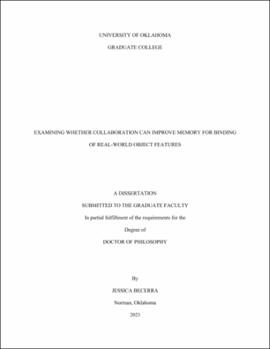| dc.description.abstract | Individuals can accurately store thousands of objects in their visual long-term memory.
However, when objects vary on numerous features, previous research found that individuals
struggle to bind the objects to their correct states (e.g., state of the studied coffee mug: full or
empty). We tested whether collaboration could serve to overcome chance-level exemplar-state
binding by conducting three recognition memory experiments. In Experiment 1A, participants
completed 2-AFC tests, in which they had to identify either which exemplars or which exemplarstate
conjunctions they had studied. Similar to previous research, we found that when
participants needed to identify the exemplar-state information together, they struggled to bind
this information and performed near-chance performance. In Experiment 1B, we used a withinsubject
design and tested whether collaboration could enhance memory for exemplar-state
binding at retrieval. To accommodate our design, we divided each task into two blocks, cutting
each task in half. We found that participants who remembered individually, and those who
worked collaboratively, demonstrated the ability to remember exemplars and the states of
exemplars they studied. Surprisingly, they were able to successfully remember this information
as a bound unit. In Experiment 2, we tested whether we could replicate this ability to
successfully bind when the task becomes more challenging. Using an old/new recognition test,
we found that participants who collaborated were able to discriminate above chance performance
for both tasks. Thus, we found evidence that exemplar-state binding is possible by individuals
who remember individually and that binding performance can be improved when individuals
collaborate to remember. However, it seems apparent that the amount of information participants
are required to bind impacts this ability. | en_US |
